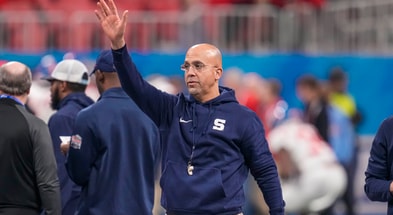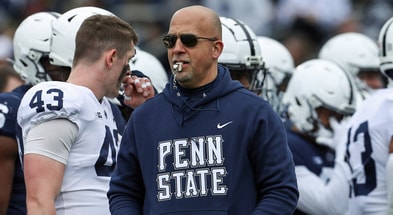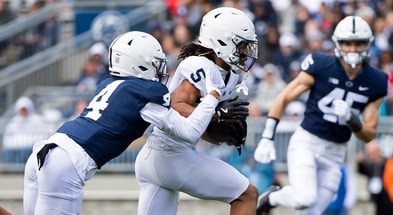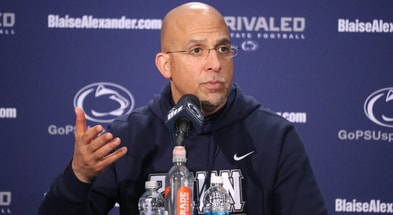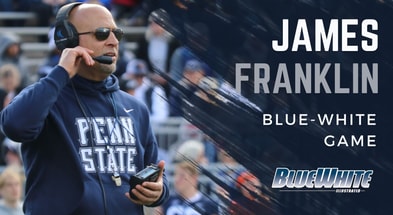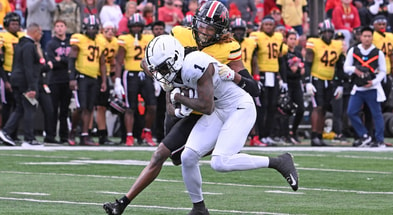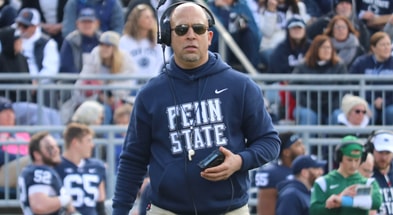At program crossroads, James Franklin will set next direction: Column
On the losing end of a 30-27 snowball fight at Spartan Stadium Saturday night, James Franklin sustained one final indignity of the 2021 regular season.
Surrounded by reporters near the concourse, his postgame press conference conducted outside as a result of COVID-19 concerns, a Michigan State fan noticed the crowd and Franklin. Clad in a green hooded sweatshirt and jeans, the bearded man shouted to anyone who’d listen.
“Go home, ya losers!” he said.
Shooting a stare in the direction of the man, Franklin offered no verbal response.
Dropping to 7-5 with the result, a free fall from a 5-0 start that lifted his Nittany Lions to No. 4 in the rankings, Franklin’s Penn State program stands at a crossroads. Saturday’s performance against the nation’s No. 12 program demonstrates as much.
Battling back from a 14-0 deficit in the first quarter, the Nittany Lions evened the score and missed an opportunity to tie or lead at the half. In the second half, a failed fourth-and-1, a midfield fumble, and a fumbled kickoff return – all in the fourth quarter – upended Penn State’s opportunity to win.
In isolation, as just about any other of Penn State’s losses on the season, the individual scenario could be viewed as a frustrating sequence for the Nittany Lions.
From Sean Clifford’s injury during a hot start at Iowa, to the lackluster passing day while still recovering against Illinois, to Ohio State’s explosive playmaking, to Michigan’s defensive clinic up front, they’re easily identifiable and reasonable explanations for Penn State to finish on the losing end of those games.
The issue for Franklin and Penn State is that the totality of the 2021 season cannot and shouldn’t be considered as a series of isolated, disparate events.
The Nittany Lions finished the regular season ranked 118th nationally for rushing offense at 107.6 yards per game because they aren’t good at it. Excluding 32 sacks for 193 yards in losses, Penn State generated 1,398 yards and 11 touchdowns on the ground on 377 carries. That isn’t efficient or effective and needs to improve at the point of attack on the offensive line, with tight end blocking, and the running backs themselves.
At just 22.8 points per game scored in the Big Ten this season, with only 22 touchdowns scored offensively, the Nittany Lions’ offense, as a whole, isn’t efficient or effective.
Defensively, the Nittany Lions were great, bordering on elite this season. Until Saturday’s game, no opponent had topped 30 offensive points scored, twice the Lions pitched shutouts, and, at 16.8 points per game for the year, the unit finished seventh nationally in scoring defense.
Concurrent to Penn State’s offensive struggles all season, though, the Nittany Lions allowed critical points scored in the fourth quarter in each of its losses. A group that repeatedly demonstrated its excellence, the late-game lapses were a blight on the program’s opportunities to win.
Even special teams, led by the inarguably talented Jordan Stout, finished the regular season making 16 of 23 field goals. More problematic than pure numbers, those misses included two within 29 yards and four misses between 40 and 49 yards. Four of seven misses on the year were in Penn State’s losses.
Those five losses, by three, two, nine, four, and three points, respectively, went for a combined 21 points. And those 4.2 points per loss tell two stories.
The first is that Penn State is close.
No fan wants to hear that in the wake of a 7-5 season. Understood. The frustrations of being close, but unable to succeed when so clearly poised to do so, are more than fair and warranted.
The second is that, in six games against quality competition, in especially difficult circumstances at Iowa, at Ohio State, and at Michigan State, Penn State and James Franklin lost four times. Putting the Illinois loss in a category of its own, for a loss-following-a-loss problem of its own, the reality is that Penn State isn’t good enough to expect to win them all.
The space between “winning them all” and “going 2-4” is vast, though. More nuanced discussions can and will be reserved for the offseason in diagnosing how an unblemished record happens. But avoiding sub-.500 in those games is something entirely within the purview of James Franklin and the Penn State football program.
In a season that has been engulfed by contract talk, and state-of-the-program, big-picture evaluation, Franklin’s holistic viewpoint takes on new meaning in the wake of the latest loss.
“It’s all of it. It’s recruiting, it’s facilities, it’s scheme, it’s coaching, it’s fundamentals, it’s strength and conditioning, it’s nutrition… It all matters,” he said. “We’ve been really close in some games. We’ve been really close in terms of getting into the Playoffs, been ranked pretty high at times, we’ve got to be able to sustain it and that’s what this is all about.”
In context, he’s not wrong about the steps that can and must be taken for Penn State to achieve its aspirations of being a nationally relevant, competitive, winning program.
But his place in that equation, responsible for maximizing the on-field production of all of the personnel at his disposal, demands circumspection in the coming weeks and months. Inevitably, that circumspection should lead James Franklin to a place in which internal player and coaching development take unequivocal precedence over everything else.
Undeniably close and competitive against the best competition, taking steps forward, not back, will depend on it.








